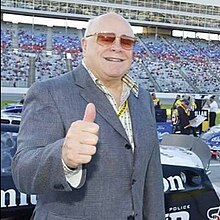Kentucky Speedway
Construction started in July 1998 and opened nearly two years later, with an ultimate goal of securing a NASCAR Cup Series race weekend in the near future.
However, after an inaugural Cup Series weekend plagued by traffic issues and lackluster revenue throughout the following decade, the facility was dropped from the NASCAR schedule starting in 2021, and has since been turned into a multi-use rental complex.
After visiting a race at the newly built Texas Motor Speedway,[8] he decided to launch a study to determine on whether building a NASCAR-style superspeedway in Northern Kentucky was feasible.
[11] In the press conference, Carroll announced his intents to build a 1,000-acre, 60,000-seat, 1.5-mile (2.4 km) track in Gallatin County, Kentucky, at the cost of $132 million.
[18] In contrast, Carroll stated that he thought NASCAR and its president Bill France Jr. had been "very loyal"; he later decided to move the groundbreaking date earlier to July 1.
[26] That same month, Carroll sold his ownership of Turfway Park, stating that the decline of the facility had left him "frustrated and somewhat burned out", wanting to focus on Kentucky Speedway's construction.
[31] By July, an IRL date was rumored to be "highly probable" according to the Courier Journal;[32] the decision was confirmed two months later, with a 300 miles (480 km) race being scheduled in August 2000.
[33] In October, the first testing runs were made by ARCA driver Bill Baird, who stated that the track was "as smooth as a baby’s bottom.
[55] The facility saw its first major injury the next year when actor and aspiring IndyCar driver Jason Priestley crashed during a test session at approximately 180 miles per hour (290 km/h), severely injuring him.
[56] Speedway officials first applied for a Cup Series race for the 2002 season; however, NASCAR rejected because they felt that including the facility "would not further its expansion goals.
[59] By June 2005, Carroll, growing frustrated at the track's lack of a Cup Series race, stating that he would seek out more aggressive tactics to gain one, including the possibility of an antitrust lawsuit.
[61] After proceedings began in December, NASCAR and ISC argued for the case to be heard in Florida, where both companies were headquartered, instead of Kentucky;[62] the proposal was dismissed by United States district judge William Bertelsman,[63] eventually ordering a one-year period of discovery for both parties set to end on February 1, 2007.
[66] In April 2007, Kentucky Speedway amended their lawsuit, no longer demanding a Cup Series race; instead, they called for the France family, owner of both NASCAR and ISC, to give up ownership of one of either of the two companies.
[72] On May 22, 2008, The Cincinnati Enquirer reported that a press conference had been scheduled with Speedway Motorsports' (SMI) Bruton Smith regarding a potential partnership with the track or its selling.
[74] With Smith purchasing the track, he aimed to add approximately 50,000 seats, additional bathrooms, increased parking space, and a renovated garage area upon confirmation of a Cup Series date.
"[78] Although Smith sought to end the appeal,[79] Carroll refused to budge, stating that "We are very, very adamant to the fact that we think we have a good lawsuit... What matters is the even playing field.
[93] A week later, Carroll officially dropped his lawsuit against NASCAR and ISC, allowing the facility to begin the eligibility process to obtain a Cup Series date.
[95] The Sixth Circuit Appeals Court denied Duchossois' request for a rehearing in February,[96] and although a trial date was scheduled for May 7, the two came to a settlement by April 30, formally ending the six-year lawsuit.
"[105] By the start of the race weekend, approximately $70 million of renovations were made, including the move of the track's pit road 200 feet closer to the frontstretch and the addition of 3,000 campsite spots.
[112] To alleviate the problem, SMI announced to spend $11 million worth of renovations, including the purchase of 219 acres (89 ha) of land and the construction of a new pedestrian walkway.
[120] Attendance also saw a major decrease over a three-year period, fueling speculation of the move of the facility's Cup Series date to another SMI-owned track.
[121] That same year, the track oversaw its first automobile-related fatality when Stephen Cox crashed his car during a Rusty Wallace Racing Experience session.
[125] The repave drew mixed reactions,[126] with Simendinger opting to add an additional asphalt layer to the track's surface because it "did not meet specifications".
[130] In a Cincinnati Enquirer analysis piece by Jason Hoffman, the decision was due to the track "succumb[ing] to its inability to bring in enough revenue for its parent company.
[133] In May 2021, amidst a global semiconductor shortage, the track was used by the Ford Motor Company to store thousands of pickup trucks waiting for computer chips.


